A Comparative Analysis of Employee Motivation Approaches
VerifiedAdded on 2020/04/29
|12
|2948
|174
Essay
AI Summary
This essay delves into the critical topic of employee motivation, examining two primary approaches: intrinsic and extrinsic motivation. It begins by defining motivation and its significance in understanding organizational behavior, highlighting its role in enhancing employee performance and organizational effectiveness. The essay then distinguishes between intrinsic motivation, driven by internal factors such as satisfaction and engagement, and extrinsic motivation, which stems from external rewards and incentives. It provides in-depth analysis of each type, discussing their respective impacts on employee behavior, performance, and overall job satisfaction. The essay offers recommendations for leveraging both intrinsic and extrinsic motivators to foster a productive and engaged workforce, emphasizing the importance of aligning motivational strategies with individual and organizational goals. Ultimately, the essay concludes that a balanced approach, incorporating both intrinsic and extrinsic elements, is essential for creating a highly motivated and successful work environment.
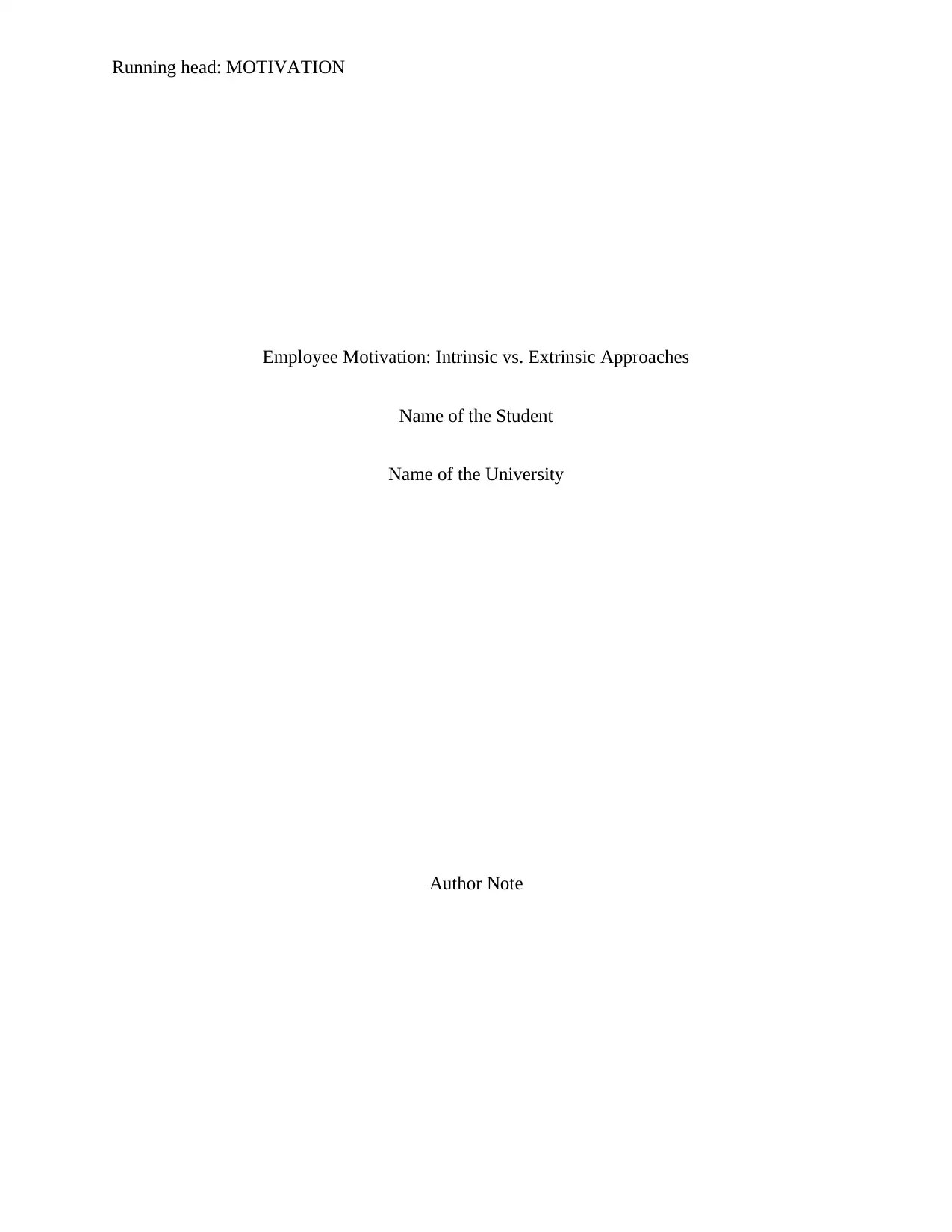
Running head: MOTIVATION
Employee Motivation: Intrinsic vs. Extrinsic Approaches
Name of the Student
Name of the University
Author Note
Employee Motivation: Intrinsic vs. Extrinsic Approaches
Name of the Student
Name of the University
Author Note
Paraphrase This Document
Need a fresh take? Get an instant paraphrase of this document with our AI Paraphraser
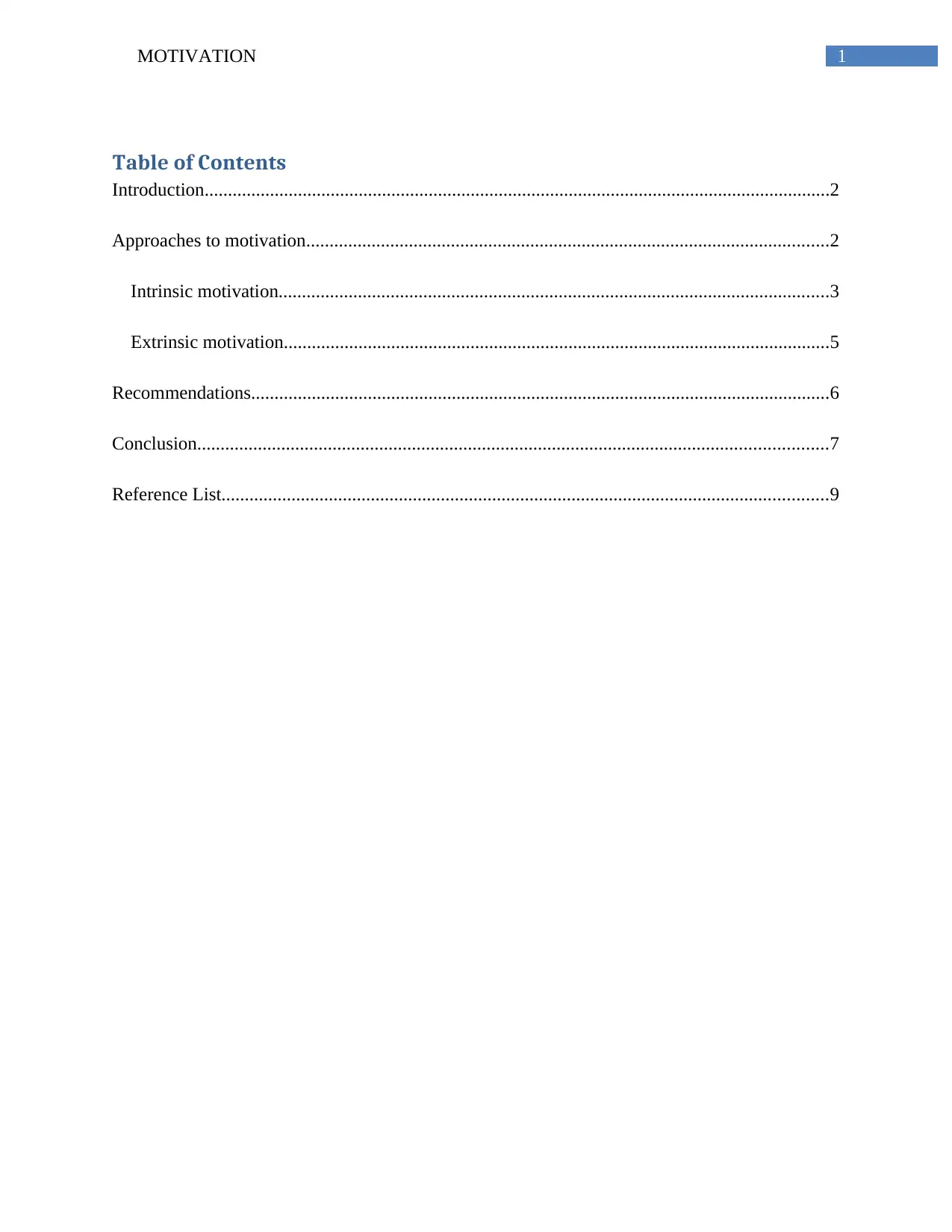
1MOTIVATION
Table of Contents
Introduction......................................................................................................................................2
Approaches to motivation................................................................................................................2
Intrinsic motivation......................................................................................................................3
Extrinsic motivation.....................................................................................................................5
Recommendations............................................................................................................................6
Conclusion.......................................................................................................................................7
Reference List..................................................................................................................................9
Table of Contents
Introduction......................................................................................................................................2
Approaches to motivation................................................................................................................2
Intrinsic motivation......................................................................................................................3
Extrinsic motivation.....................................................................................................................5
Recommendations............................................................................................................................6
Conclusion.......................................................................................................................................7
Reference List..................................................................................................................................9
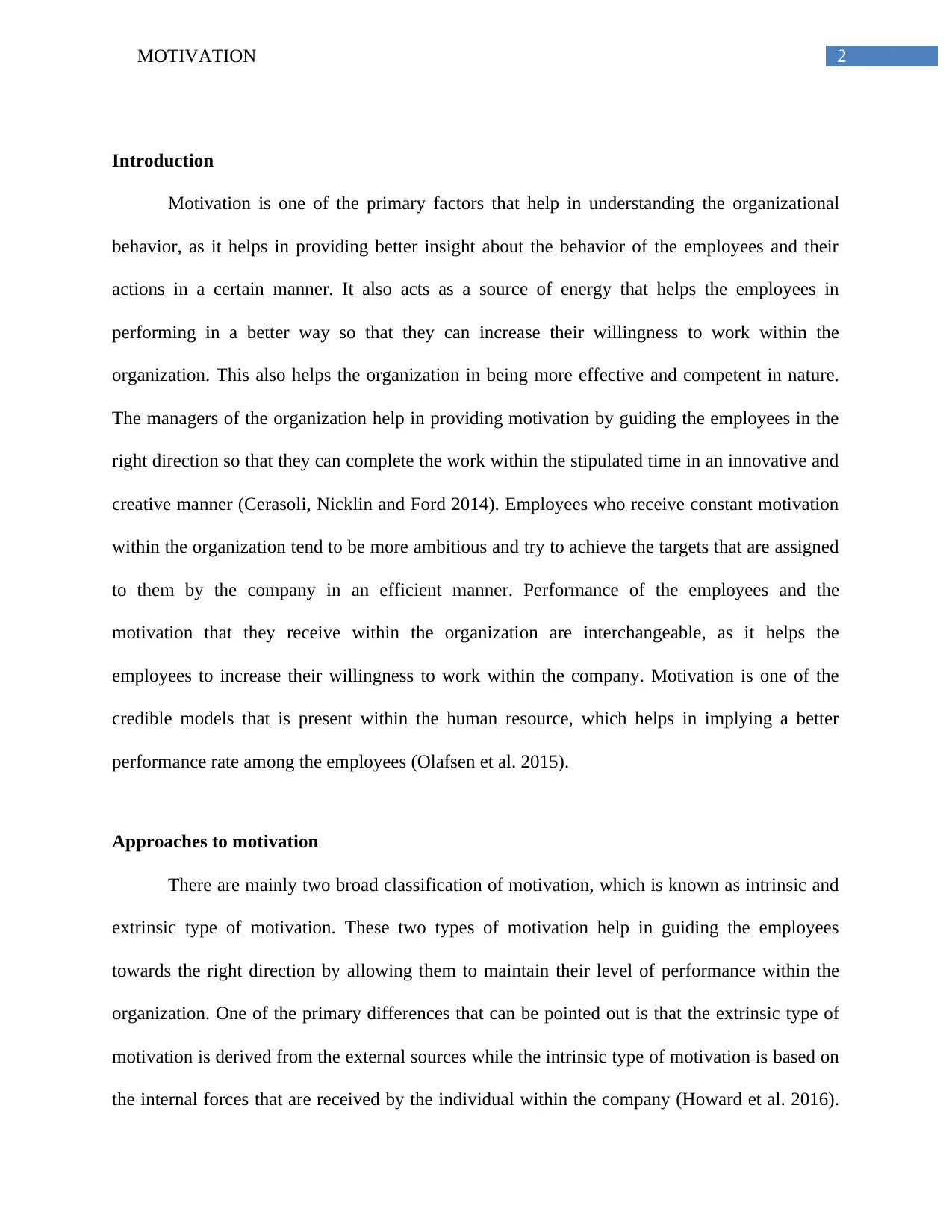
2MOTIVATION
Introduction
Motivation is one of the primary factors that help in understanding the organizational
behavior, as it helps in providing better insight about the behavior of the employees and their
actions in a certain manner. It also acts as a source of energy that helps the employees in
performing in a better way so that they can increase their willingness to work within the
organization. This also helps the organization in being more effective and competent in nature.
The managers of the organization help in providing motivation by guiding the employees in the
right direction so that they can complete the work within the stipulated time in an innovative and
creative manner (Cerasoli, Nicklin and Ford 2014). Employees who receive constant motivation
within the organization tend to be more ambitious and try to achieve the targets that are assigned
to them by the company in an efficient manner. Performance of the employees and the
motivation that they receive within the organization are interchangeable, as it helps the
employees to increase their willingness to work within the company. Motivation is one of the
credible models that is present within the human resource, which helps in implying a better
performance rate among the employees (Olafsen et al. 2015).
Approaches to motivation
There are mainly two broad classification of motivation, which is known as intrinsic and
extrinsic type of motivation. These two types of motivation help in guiding the employees
towards the right direction by allowing them to maintain their level of performance within the
organization. One of the primary differences that can be pointed out is that the extrinsic type of
motivation is derived from the external sources while the intrinsic type of motivation is based on
the internal forces that are received by the individual within the company (Howard et al. 2016).
Introduction
Motivation is one of the primary factors that help in understanding the organizational
behavior, as it helps in providing better insight about the behavior of the employees and their
actions in a certain manner. It also acts as a source of energy that helps the employees in
performing in a better way so that they can increase their willingness to work within the
organization. This also helps the organization in being more effective and competent in nature.
The managers of the organization help in providing motivation by guiding the employees in the
right direction so that they can complete the work within the stipulated time in an innovative and
creative manner (Cerasoli, Nicklin and Ford 2014). Employees who receive constant motivation
within the organization tend to be more ambitious and try to achieve the targets that are assigned
to them by the company in an efficient manner. Performance of the employees and the
motivation that they receive within the organization are interchangeable, as it helps the
employees to increase their willingness to work within the company. Motivation is one of the
credible models that is present within the human resource, which helps in implying a better
performance rate among the employees (Olafsen et al. 2015).
Approaches to motivation
There are mainly two broad classification of motivation, which is known as intrinsic and
extrinsic type of motivation. These two types of motivation help in guiding the employees
towards the right direction by allowing them to maintain their level of performance within the
organization. One of the primary differences that can be pointed out is that the extrinsic type of
motivation is derived from the external sources while the intrinsic type of motivation is based on
the internal forces that are received by the individual within the company (Howard et al. 2016).
⊘ This is a preview!⊘
Do you want full access?
Subscribe today to unlock all pages.

Trusted by 1+ million students worldwide
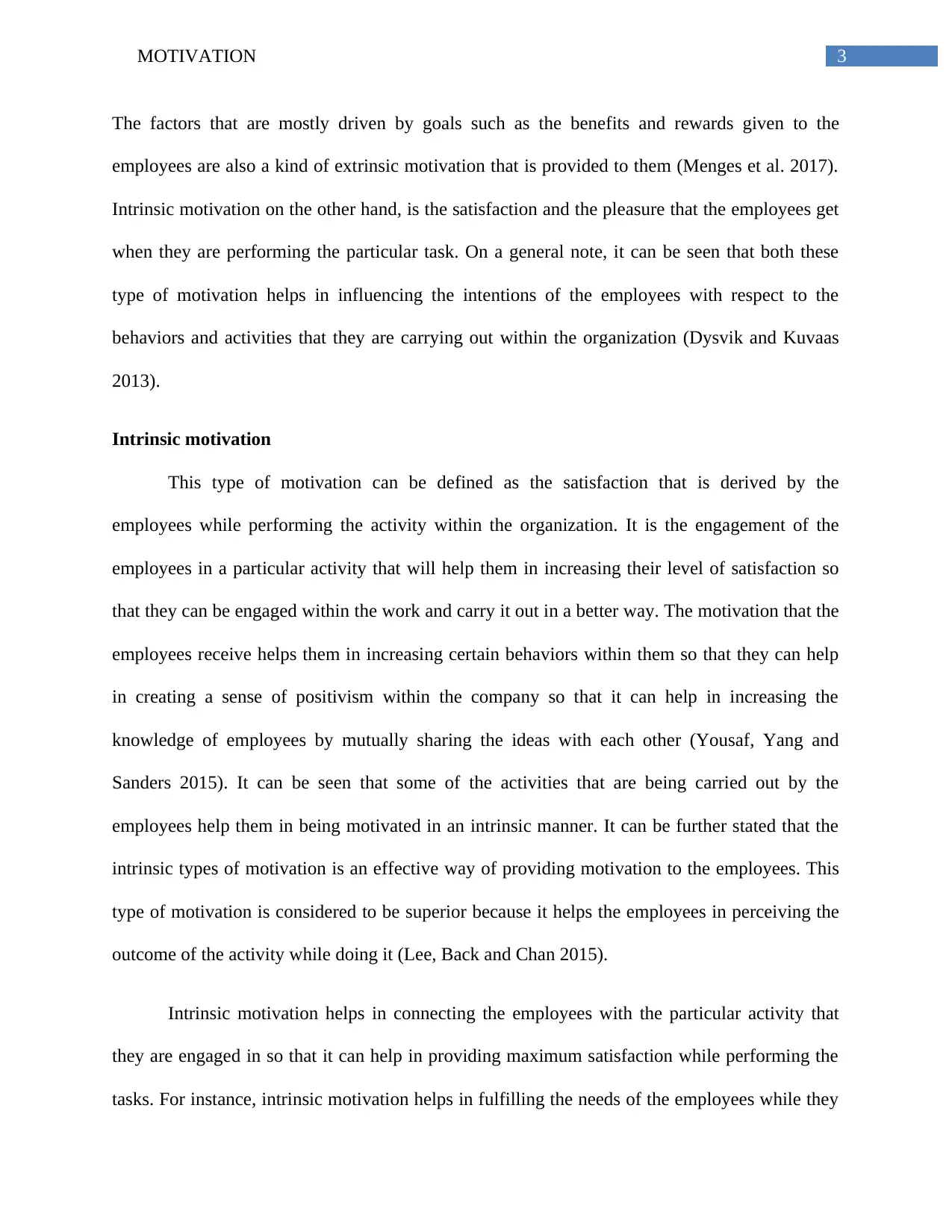
3MOTIVATION
The factors that are mostly driven by goals such as the benefits and rewards given to the
employees are also a kind of extrinsic motivation that is provided to them (Menges et al. 2017).
Intrinsic motivation on the other hand, is the satisfaction and the pleasure that the employees get
when they are performing the particular task. On a general note, it can be seen that both these
type of motivation helps in influencing the intentions of the employees with respect to the
behaviors and activities that they are carrying out within the organization (Dysvik and Kuvaas
2013).
Intrinsic motivation
This type of motivation can be defined as the satisfaction that is derived by the
employees while performing the activity within the organization. It is the engagement of the
employees in a particular activity that will help them in increasing their level of satisfaction so
that they can be engaged within the work and carry it out in a better way. The motivation that the
employees receive helps them in increasing certain behaviors within them so that they can help
in creating a sense of positivism within the company so that it can help in increasing the
knowledge of employees by mutually sharing the ideas with each other (Yousaf, Yang and
Sanders 2015). It can be seen that some of the activities that are being carried out by the
employees help them in being motivated in an intrinsic manner. It can be further stated that the
intrinsic types of motivation is an effective way of providing motivation to the employees. This
type of motivation is considered to be superior because it helps the employees in perceiving the
outcome of the activity while doing it (Lee, Back and Chan 2015).
Intrinsic motivation helps in connecting the employees with the particular activity that
they are engaged in so that it can help in providing maximum satisfaction while performing the
tasks. For instance, intrinsic motivation helps in fulfilling the needs of the employees while they
The factors that are mostly driven by goals such as the benefits and rewards given to the
employees are also a kind of extrinsic motivation that is provided to them (Menges et al. 2017).
Intrinsic motivation on the other hand, is the satisfaction and the pleasure that the employees get
when they are performing the particular task. On a general note, it can be seen that both these
type of motivation helps in influencing the intentions of the employees with respect to the
behaviors and activities that they are carrying out within the organization (Dysvik and Kuvaas
2013).
Intrinsic motivation
This type of motivation can be defined as the satisfaction that is derived by the
employees while performing the activity within the organization. It is the engagement of the
employees in a particular activity that will help them in increasing their level of satisfaction so
that they can be engaged within the work and carry it out in a better way. The motivation that the
employees receive helps them in increasing certain behaviors within them so that they can help
in creating a sense of positivism within the company so that it can help in increasing the
knowledge of employees by mutually sharing the ideas with each other (Yousaf, Yang and
Sanders 2015). It can be seen that some of the activities that are being carried out by the
employees help them in being motivated in an intrinsic manner. It can be further stated that the
intrinsic types of motivation is an effective way of providing motivation to the employees. This
type of motivation is considered to be superior because it helps the employees in perceiving the
outcome of the activity while doing it (Lee, Back and Chan 2015).
Intrinsic motivation helps in connecting the employees with the particular activity that
they are engaged in so that it can help in providing maximum satisfaction while performing the
tasks. For instance, intrinsic motivation helps in fulfilling the needs of the employees while they
Paraphrase This Document
Need a fresh take? Get an instant paraphrase of this document with our AI Paraphraser
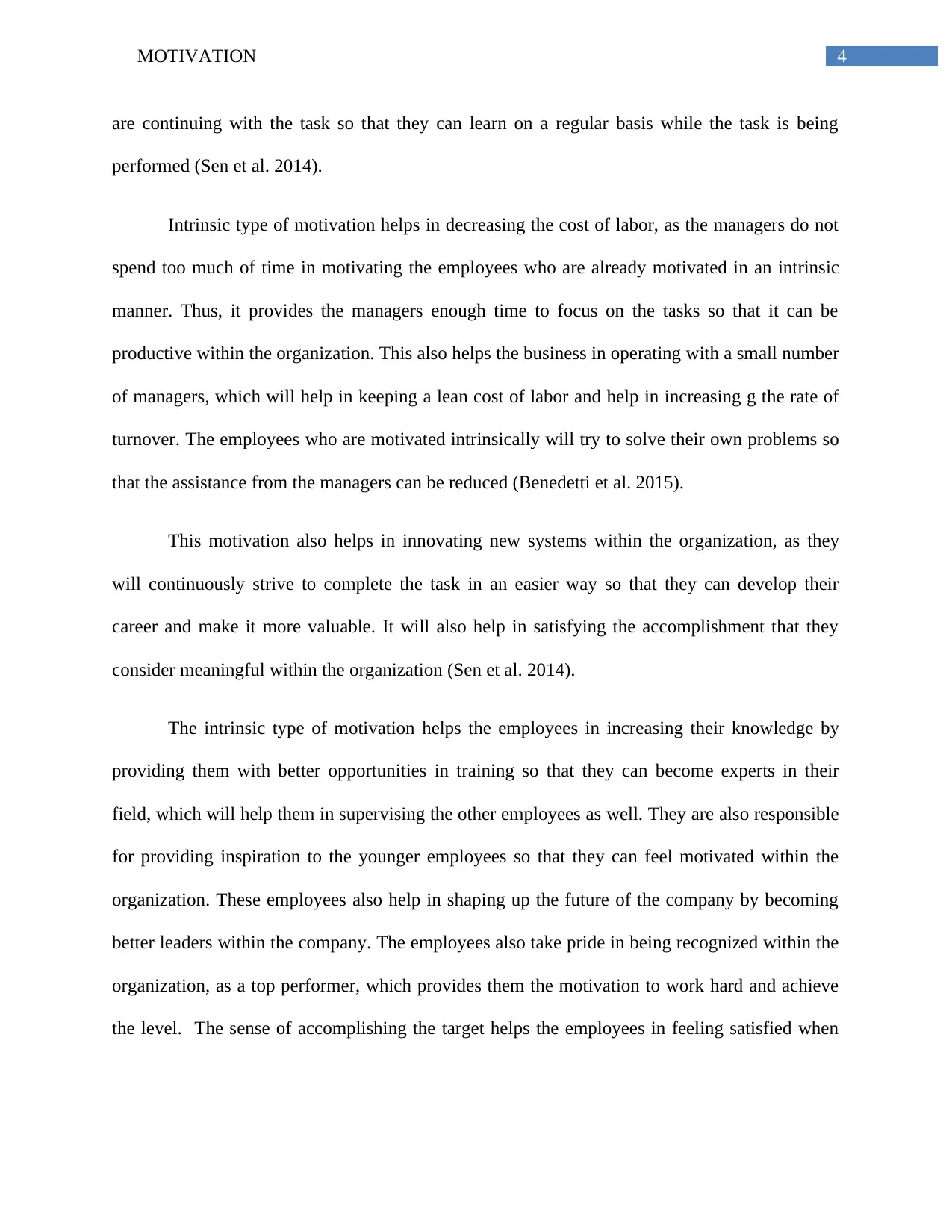
4MOTIVATION
are continuing with the task so that they can learn on a regular basis while the task is being
performed (Sen et al. 2014).
Intrinsic type of motivation helps in decreasing the cost of labor, as the managers do not
spend too much of time in motivating the employees who are already motivated in an intrinsic
manner. Thus, it provides the managers enough time to focus on the tasks so that it can be
productive within the organization. This also helps the business in operating with a small number
of managers, which will help in keeping a lean cost of labor and help in increasing g the rate of
turnover. The employees who are motivated intrinsically will try to solve their own problems so
that the assistance from the managers can be reduced (Benedetti et al. 2015).
This motivation also helps in innovating new systems within the organization, as they
will continuously strive to complete the task in an easier way so that they can develop their
career and make it more valuable. It will also help in satisfying the accomplishment that they
consider meaningful within the organization (Sen et al. 2014).
The intrinsic type of motivation helps the employees in increasing their knowledge by
providing them with better opportunities in training so that they can become experts in their
field, which will help them in supervising the other employees as well. They are also responsible
for providing inspiration to the younger employees so that they can feel motivated within the
organization. These employees also help in shaping up the future of the company by becoming
better leaders within the company. The employees also take pride in being recognized within the
organization, as a top performer, which provides them the motivation to work hard and achieve
the level. The sense of accomplishing the target helps the employees in feeling satisfied when
are continuing with the task so that they can learn on a regular basis while the task is being
performed (Sen et al. 2014).
Intrinsic type of motivation helps in decreasing the cost of labor, as the managers do not
spend too much of time in motivating the employees who are already motivated in an intrinsic
manner. Thus, it provides the managers enough time to focus on the tasks so that it can be
productive within the organization. This also helps the business in operating with a small number
of managers, which will help in keeping a lean cost of labor and help in increasing g the rate of
turnover. The employees who are motivated intrinsically will try to solve their own problems so
that the assistance from the managers can be reduced (Benedetti et al. 2015).
This motivation also helps in innovating new systems within the organization, as they
will continuously strive to complete the task in an easier way so that they can develop their
career and make it more valuable. It will also help in satisfying the accomplishment that they
consider meaningful within the organization (Sen et al. 2014).
The intrinsic type of motivation helps the employees in increasing their knowledge by
providing them with better opportunities in training so that they can become experts in their
field, which will help them in supervising the other employees as well. They are also responsible
for providing inspiration to the younger employees so that they can feel motivated within the
organization. These employees also help in shaping up the future of the company by becoming
better leaders within the company. The employees also take pride in being recognized within the
organization, as a top performer, which provides them the motivation to work hard and achieve
the level. The sense of accomplishing the target helps the employees in feeling satisfied when
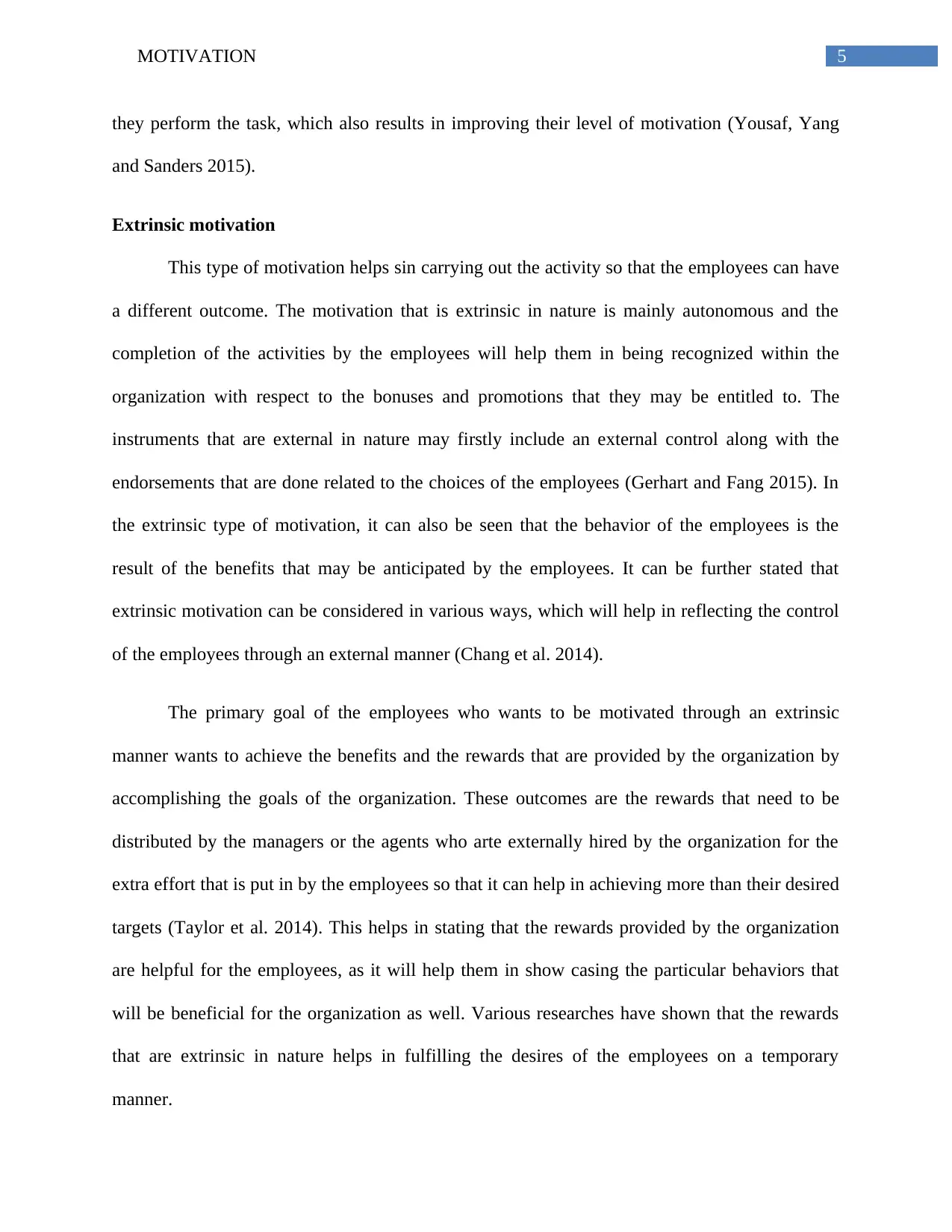
5MOTIVATION
they perform the task, which also results in improving their level of motivation (Yousaf, Yang
and Sanders 2015).
Extrinsic motivation
This type of motivation helps sin carrying out the activity so that the employees can have
a different outcome. The motivation that is extrinsic in nature is mainly autonomous and the
completion of the activities by the employees will help them in being recognized within the
organization with respect to the bonuses and promotions that they may be entitled to. The
instruments that are external in nature may firstly include an external control along with the
endorsements that are done related to the choices of the employees (Gerhart and Fang 2015). In
the extrinsic type of motivation, it can also be seen that the behavior of the employees is the
result of the benefits that may be anticipated by the employees. It can be further stated that
extrinsic motivation can be considered in various ways, which will help in reflecting the control
of the employees through an external manner (Chang et al. 2014).
The primary goal of the employees who wants to be motivated through an extrinsic
manner wants to achieve the benefits and the rewards that are provided by the organization by
accomplishing the goals of the organization. These outcomes are the rewards that need to be
distributed by the managers or the agents who arte externally hired by the organization for the
extra effort that is put in by the employees so that it can help in achieving more than their desired
targets (Taylor et al. 2014). This helps in stating that the rewards provided by the organization
are helpful for the employees, as it will help them in show casing the particular behaviors that
will be beneficial for the organization as well. Various researches have shown that the rewards
that are extrinsic in nature helps in fulfilling the desires of the employees on a temporary
manner.
they perform the task, which also results in improving their level of motivation (Yousaf, Yang
and Sanders 2015).
Extrinsic motivation
This type of motivation helps sin carrying out the activity so that the employees can have
a different outcome. The motivation that is extrinsic in nature is mainly autonomous and the
completion of the activities by the employees will help them in being recognized within the
organization with respect to the bonuses and promotions that they may be entitled to. The
instruments that are external in nature may firstly include an external control along with the
endorsements that are done related to the choices of the employees (Gerhart and Fang 2015). In
the extrinsic type of motivation, it can also be seen that the behavior of the employees is the
result of the benefits that may be anticipated by the employees. It can be further stated that
extrinsic motivation can be considered in various ways, which will help in reflecting the control
of the employees through an external manner (Chang et al. 2014).
The primary goal of the employees who wants to be motivated through an extrinsic
manner wants to achieve the benefits and the rewards that are provided by the organization by
accomplishing the goals of the organization. These outcomes are the rewards that need to be
distributed by the managers or the agents who arte externally hired by the organization for the
extra effort that is put in by the employees so that it can help in achieving more than their desired
targets (Taylor et al. 2014). This helps in stating that the rewards provided by the organization
are helpful for the employees, as it will help them in show casing the particular behaviors that
will be beneficial for the organization as well. Various researches have shown that the rewards
that are extrinsic in nature helps in fulfilling the desires of the employees on a temporary
manner.
⊘ This is a preview!⊘
Do you want full access?
Subscribe today to unlock all pages.

Trusted by 1+ million students worldwide
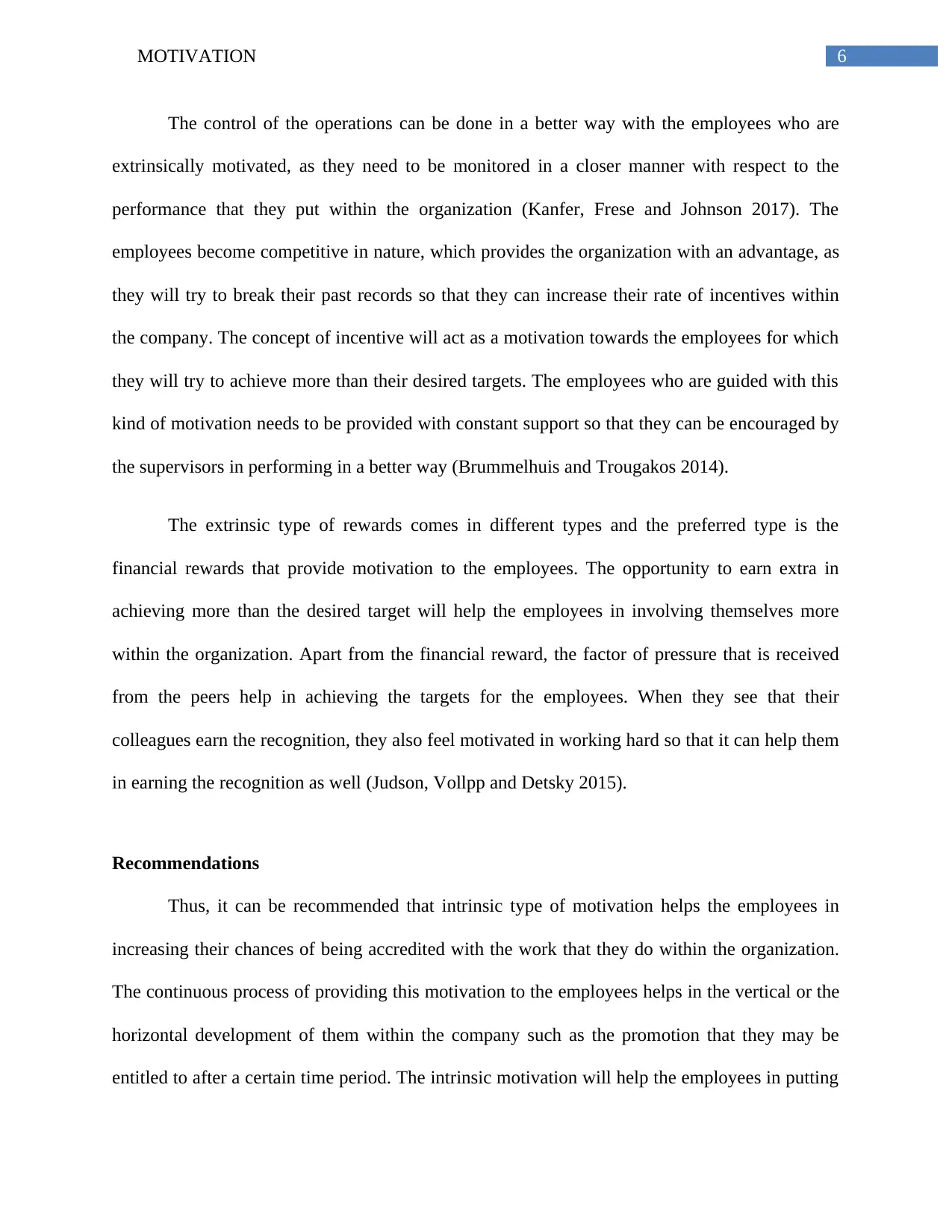
6MOTIVATION
The control of the operations can be done in a better way with the employees who are
extrinsically motivated, as they need to be monitored in a closer manner with respect to the
performance that they put within the organization (Kanfer, Frese and Johnson 2017). The
employees become competitive in nature, which provides the organization with an advantage, as
they will try to break their past records so that they can increase their rate of incentives within
the company. The concept of incentive will act as a motivation towards the employees for which
they will try to achieve more than their desired targets. The employees who are guided with this
kind of motivation needs to be provided with constant support so that they can be encouraged by
the supervisors in performing in a better way (Brummelhuis and Trougakos 2014).
The extrinsic type of rewards comes in different types and the preferred type is the
financial rewards that provide motivation to the employees. The opportunity to earn extra in
achieving more than the desired target will help the employees in involving themselves more
within the organization. Apart from the financial reward, the factor of pressure that is received
from the peers help in achieving the targets for the employees. When they see that their
colleagues earn the recognition, they also feel motivated in working hard so that it can help them
in earning the recognition as well (Judson, Vollpp and Detsky 2015).
Recommendations
Thus, it can be recommended that intrinsic type of motivation helps the employees in
increasing their chances of being accredited with the work that they do within the organization.
The continuous process of providing this motivation to the employees helps in the vertical or the
horizontal development of them within the company such as the promotion that they may be
entitled to after a certain time period. The intrinsic motivation will help the employees in putting
The control of the operations can be done in a better way with the employees who are
extrinsically motivated, as they need to be monitored in a closer manner with respect to the
performance that they put within the organization (Kanfer, Frese and Johnson 2017). The
employees become competitive in nature, which provides the organization with an advantage, as
they will try to break their past records so that they can increase their rate of incentives within
the company. The concept of incentive will act as a motivation towards the employees for which
they will try to achieve more than their desired targets. The employees who are guided with this
kind of motivation needs to be provided with constant support so that they can be encouraged by
the supervisors in performing in a better way (Brummelhuis and Trougakos 2014).
The extrinsic type of rewards comes in different types and the preferred type is the
financial rewards that provide motivation to the employees. The opportunity to earn extra in
achieving more than the desired target will help the employees in involving themselves more
within the organization. Apart from the financial reward, the factor of pressure that is received
from the peers help in achieving the targets for the employees. When they see that their
colleagues earn the recognition, they also feel motivated in working hard so that it can help them
in earning the recognition as well (Judson, Vollpp and Detsky 2015).
Recommendations
Thus, it can be recommended that intrinsic type of motivation helps the employees in
increasing their chances of being accredited with the work that they do within the organization.
The continuous process of providing this motivation to the employees helps in the vertical or the
horizontal development of them within the company such as the promotion that they may be
entitled to after a certain time period. The intrinsic motivation will help the employees in putting
Paraphrase This Document
Need a fresh take? Get an instant paraphrase of this document with our AI Paraphraser
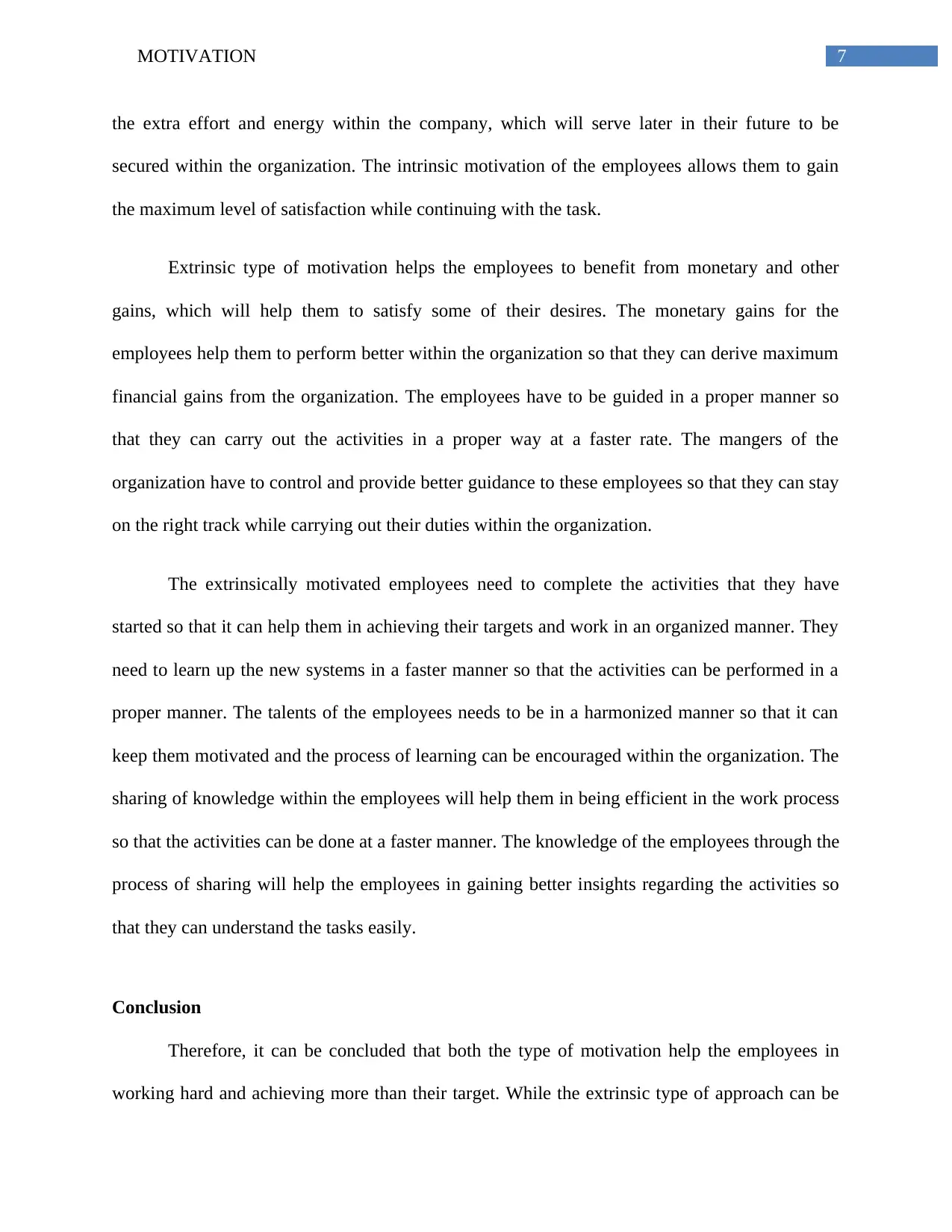
7MOTIVATION
the extra effort and energy within the company, which will serve later in their future to be
secured within the organization. The intrinsic motivation of the employees allows them to gain
the maximum level of satisfaction while continuing with the task.
Extrinsic type of motivation helps the employees to benefit from monetary and other
gains, which will help them to satisfy some of their desires. The monetary gains for the
employees help them to perform better within the organization so that they can derive maximum
financial gains from the organization. The employees have to be guided in a proper manner so
that they can carry out the activities in a proper way at a faster rate. The mangers of the
organization have to control and provide better guidance to these employees so that they can stay
on the right track while carrying out their duties within the organization.
The extrinsically motivated employees need to complete the activities that they have
started so that it can help them in achieving their targets and work in an organized manner. They
need to learn up the new systems in a faster manner so that the activities can be performed in a
proper manner. The talents of the employees needs to be in a harmonized manner so that it can
keep them motivated and the process of learning can be encouraged within the organization. The
sharing of knowledge within the employees will help them in being efficient in the work process
so that the activities can be done at a faster manner. The knowledge of the employees through the
process of sharing will help the employees in gaining better insights regarding the activities so
that they can understand the tasks easily.
Conclusion
Therefore, it can be concluded that both the type of motivation help the employees in
working hard and achieving more than their target. While the extrinsic type of approach can be
the extra effort and energy within the company, which will serve later in their future to be
secured within the organization. The intrinsic motivation of the employees allows them to gain
the maximum level of satisfaction while continuing with the task.
Extrinsic type of motivation helps the employees to benefit from monetary and other
gains, which will help them to satisfy some of their desires. The monetary gains for the
employees help them to perform better within the organization so that they can derive maximum
financial gains from the organization. The employees have to be guided in a proper manner so
that they can carry out the activities in a proper way at a faster rate. The mangers of the
organization have to control and provide better guidance to these employees so that they can stay
on the right track while carrying out their duties within the organization.
The extrinsically motivated employees need to complete the activities that they have
started so that it can help them in achieving their targets and work in an organized manner. They
need to learn up the new systems in a faster manner so that the activities can be performed in a
proper manner. The talents of the employees needs to be in a harmonized manner so that it can
keep them motivated and the process of learning can be encouraged within the organization. The
sharing of knowledge within the employees will help them in being efficient in the work process
so that the activities can be done at a faster manner. The knowledge of the employees through the
process of sharing will help the employees in gaining better insights regarding the activities so
that they can understand the tasks easily.
Conclusion
Therefore, it can be concluded that both the type of motivation help the employees in
working hard and achieving more than their target. While the extrinsic type of approach can be
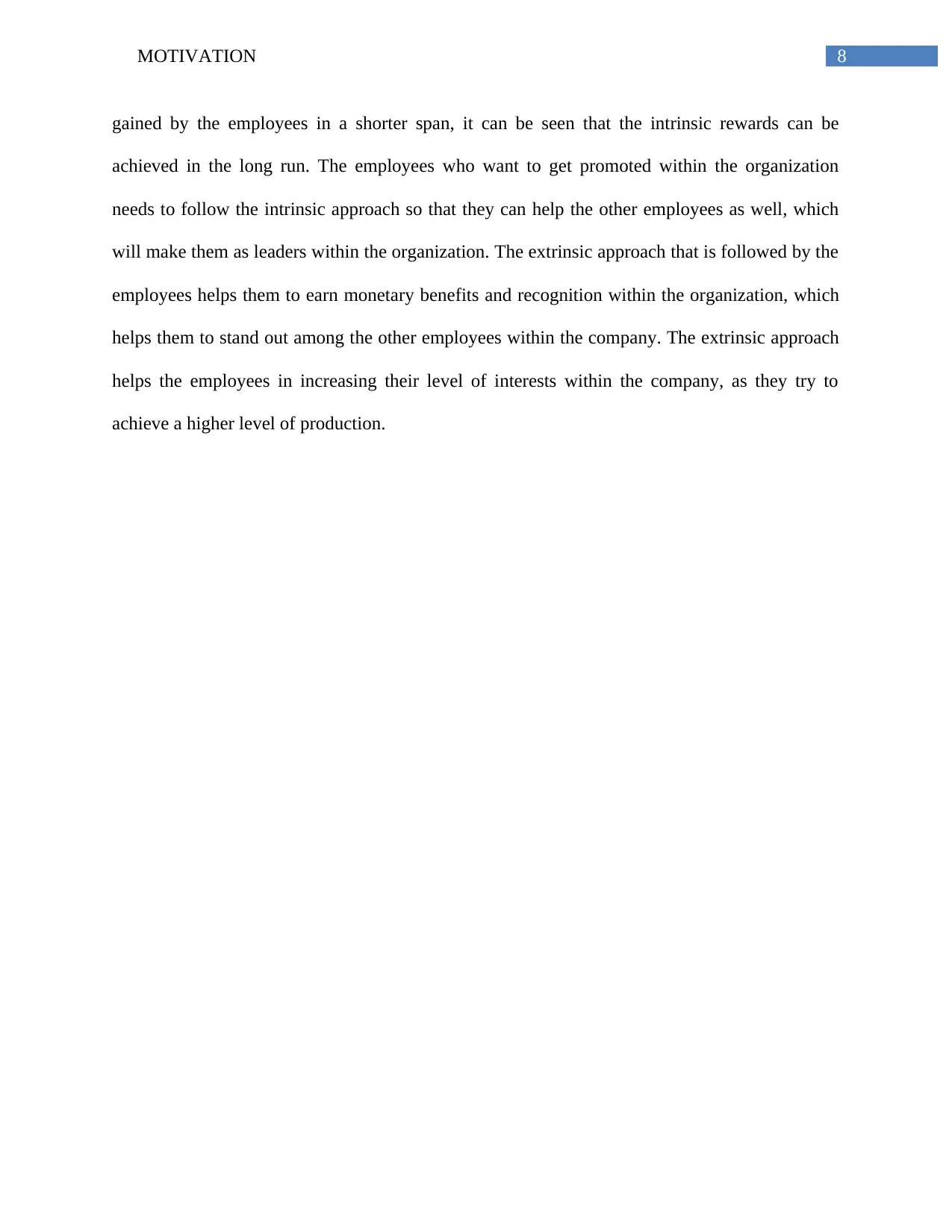
8MOTIVATION
gained by the employees in a shorter span, it can be seen that the intrinsic rewards can be
achieved in the long run. The employees who want to get promoted within the organization
needs to follow the intrinsic approach so that they can help the other employees as well, which
will make them as leaders within the organization. The extrinsic approach that is followed by the
employees helps them to earn monetary benefits and recognition within the organization, which
helps them to stand out among the other employees within the company. The extrinsic approach
helps the employees in increasing their level of interests within the company, as they try to
achieve a higher level of production.
gained by the employees in a shorter span, it can be seen that the intrinsic rewards can be
achieved in the long run. The employees who want to get promoted within the organization
needs to follow the intrinsic approach so that they can help the other employees as well, which
will make them as leaders within the organization. The extrinsic approach that is followed by the
employees helps them to earn monetary benefits and recognition within the organization, which
helps them to stand out among the other employees within the company. The extrinsic approach
helps the employees in increasing their level of interests within the company, as they try to
achieve a higher level of production.
⊘ This is a preview!⊘
Do you want full access?
Subscribe today to unlock all pages.

Trusted by 1+ million students worldwide
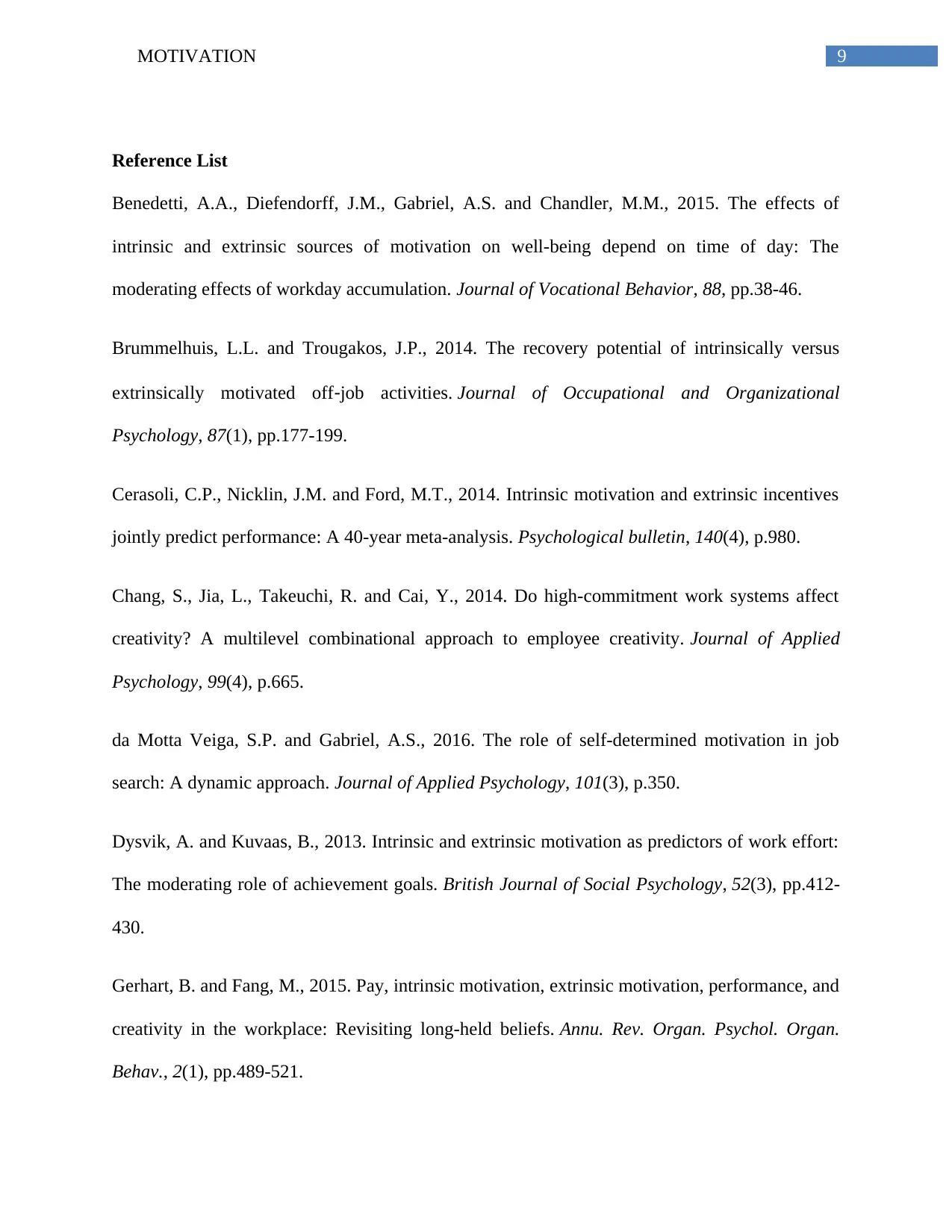
9MOTIVATION
Reference List
Benedetti, A.A., Diefendorff, J.M., Gabriel, A.S. and Chandler, M.M., 2015. The effects of
intrinsic and extrinsic sources of motivation on well-being depend on time of day: The
moderating effects of workday accumulation. Journal of Vocational Behavior, 88, pp.38-46.
Brummelhuis, L.L. and Trougakos, J.P., 2014. The recovery potential of intrinsically versus
extrinsically motivated off‐job activities. Journal of Occupational and Organizational
Psychology, 87(1), pp.177-199.
Cerasoli, C.P., Nicklin, J.M. and Ford, M.T., 2014. Intrinsic motivation and extrinsic incentives
jointly predict performance: A 40-year meta-analysis. Psychological bulletin, 140(4), p.980.
Chang, S., Jia, L., Takeuchi, R. and Cai, Y., 2014. Do high-commitment work systems affect
creativity? A multilevel combinational approach to employee creativity. Journal of Applied
Psychology, 99(4), p.665.
da Motta Veiga, S.P. and Gabriel, A.S., 2016. The role of self-determined motivation in job
search: A dynamic approach. Journal of Applied Psychology, 101(3), p.350.
Dysvik, A. and Kuvaas, B., 2013. Intrinsic and extrinsic motivation as predictors of work effort:
The moderating role of achievement goals. British Journal of Social Psychology, 52(3), pp.412-
430.
Gerhart, B. and Fang, M., 2015. Pay, intrinsic motivation, extrinsic motivation, performance, and
creativity in the workplace: Revisiting long-held beliefs. Annu. Rev. Organ. Psychol. Organ.
Behav., 2(1), pp.489-521.
Reference List
Benedetti, A.A., Diefendorff, J.M., Gabriel, A.S. and Chandler, M.M., 2015. The effects of
intrinsic and extrinsic sources of motivation on well-being depend on time of day: The
moderating effects of workday accumulation. Journal of Vocational Behavior, 88, pp.38-46.
Brummelhuis, L.L. and Trougakos, J.P., 2014. The recovery potential of intrinsically versus
extrinsically motivated off‐job activities. Journal of Occupational and Organizational
Psychology, 87(1), pp.177-199.
Cerasoli, C.P., Nicklin, J.M. and Ford, M.T., 2014. Intrinsic motivation and extrinsic incentives
jointly predict performance: A 40-year meta-analysis. Psychological bulletin, 140(4), p.980.
Chang, S., Jia, L., Takeuchi, R. and Cai, Y., 2014. Do high-commitment work systems affect
creativity? A multilevel combinational approach to employee creativity. Journal of Applied
Psychology, 99(4), p.665.
da Motta Veiga, S.P. and Gabriel, A.S., 2016. The role of self-determined motivation in job
search: A dynamic approach. Journal of Applied Psychology, 101(3), p.350.
Dysvik, A. and Kuvaas, B., 2013. Intrinsic and extrinsic motivation as predictors of work effort:
The moderating role of achievement goals. British Journal of Social Psychology, 52(3), pp.412-
430.
Gerhart, B. and Fang, M., 2015. Pay, intrinsic motivation, extrinsic motivation, performance, and
creativity in the workplace: Revisiting long-held beliefs. Annu. Rev. Organ. Psychol. Organ.
Behav., 2(1), pp.489-521.
Paraphrase This Document
Need a fresh take? Get an instant paraphrase of this document with our AI Paraphraser
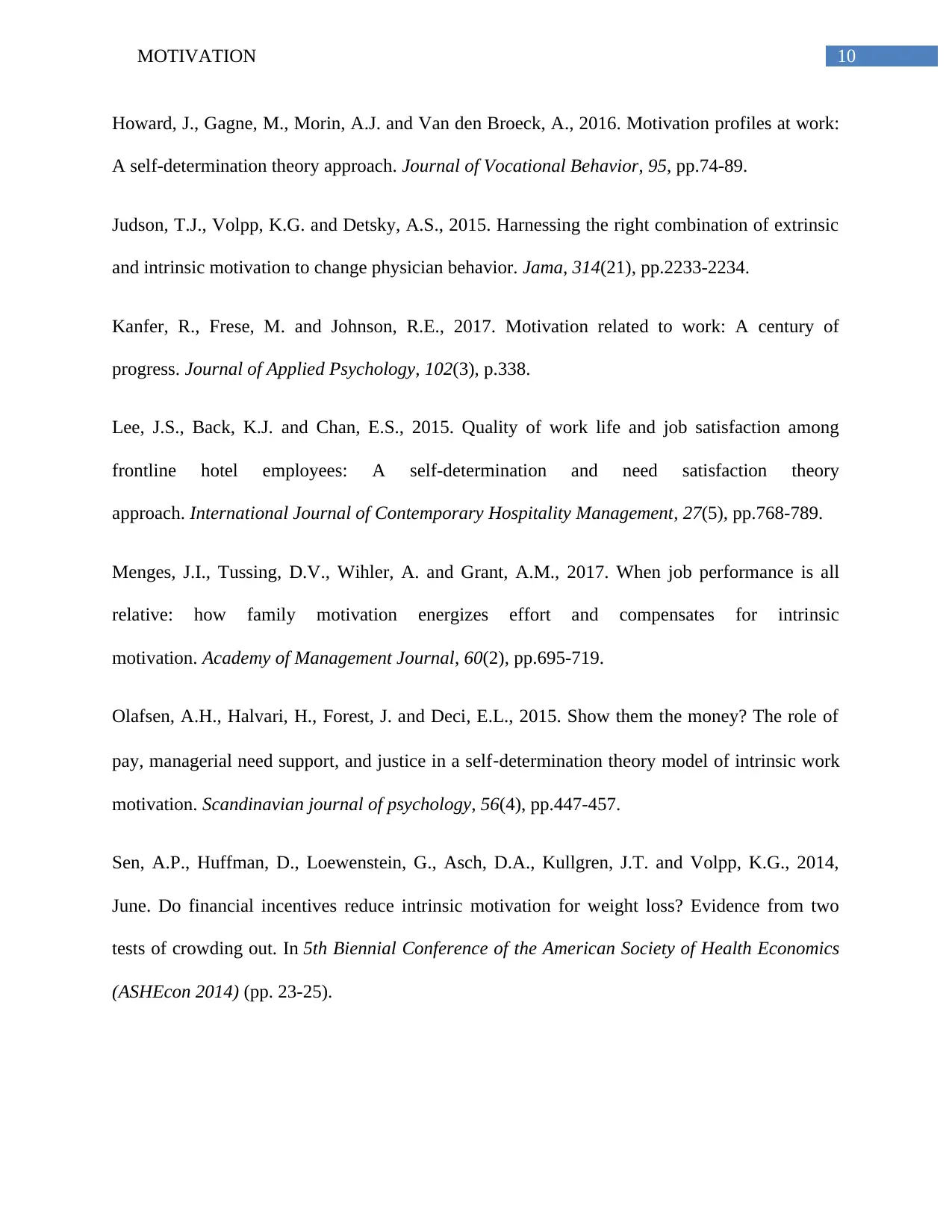
10MOTIVATION
Howard, J., Gagne, M., Morin, A.J. and Van den Broeck, A., 2016. Motivation profiles at work:
A self-determination theory approach. Journal of Vocational Behavior, 95, pp.74-89.
Judson, T.J., Volpp, K.G. and Detsky, A.S., 2015. Harnessing the right combination of extrinsic
and intrinsic motivation to change physician behavior. Jama, 314(21), pp.2233-2234.
Kanfer, R., Frese, M. and Johnson, R.E., 2017. Motivation related to work: A century of
progress. Journal of Applied Psychology, 102(3), p.338.
Lee, J.S., Back, K.J. and Chan, E.S., 2015. Quality of work life and job satisfaction among
frontline hotel employees: A self-determination and need satisfaction theory
approach. International Journal of Contemporary Hospitality Management, 27(5), pp.768-789.
Menges, J.I., Tussing, D.V., Wihler, A. and Grant, A.M., 2017. When job performance is all
relative: how family motivation energizes effort and compensates for intrinsic
motivation. Academy of Management Journal, 60(2), pp.695-719.
Olafsen, A.H., Halvari, H., Forest, J. and Deci, E.L., 2015. Show them the money? The role of
pay, managerial need support, and justice in a self‐determination theory model of intrinsic work
motivation. Scandinavian journal of psychology, 56(4), pp.447-457.
Sen, A.P., Huffman, D., Loewenstein, G., Asch, D.A., Kullgren, J.T. and Volpp, K.G., 2014,
June. Do financial incentives reduce intrinsic motivation for weight loss? Evidence from two
tests of crowding out. In 5th Biennial Conference of the American Society of Health Economics
(ASHEcon 2014) (pp. 23-25).
Howard, J., Gagne, M., Morin, A.J. and Van den Broeck, A., 2016. Motivation profiles at work:
A self-determination theory approach. Journal of Vocational Behavior, 95, pp.74-89.
Judson, T.J., Volpp, K.G. and Detsky, A.S., 2015. Harnessing the right combination of extrinsic
and intrinsic motivation to change physician behavior. Jama, 314(21), pp.2233-2234.
Kanfer, R., Frese, M. and Johnson, R.E., 2017. Motivation related to work: A century of
progress. Journal of Applied Psychology, 102(3), p.338.
Lee, J.S., Back, K.J. and Chan, E.S., 2015. Quality of work life and job satisfaction among
frontline hotel employees: A self-determination and need satisfaction theory
approach. International Journal of Contemporary Hospitality Management, 27(5), pp.768-789.
Menges, J.I., Tussing, D.V., Wihler, A. and Grant, A.M., 2017. When job performance is all
relative: how family motivation energizes effort and compensates for intrinsic
motivation. Academy of Management Journal, 60(2), pp.695-719.
Olafsen, A.H., Halvari, H., Forest, J. and Deci, E.L., 2015. Show them the money? The role of
pay, managerial need support, and justice in a self‐determination theory model of intrinsic work
motivation. Scandinavian journal of psychology, 56(4), pp.447-457.
Sen, A.P., Huffman, D., Loewenstein, G., Asch, D.A., Kullgren, J.T. and Volpp, K.G., 2014,
June. Do financial incentives reduce intrinsic motivation for weight loss? Evidence from two
tests of crowding out. In 5th Biennial Conference of the American Society of Health Economics
(ASHEcon 2014) (pp. 23-25).
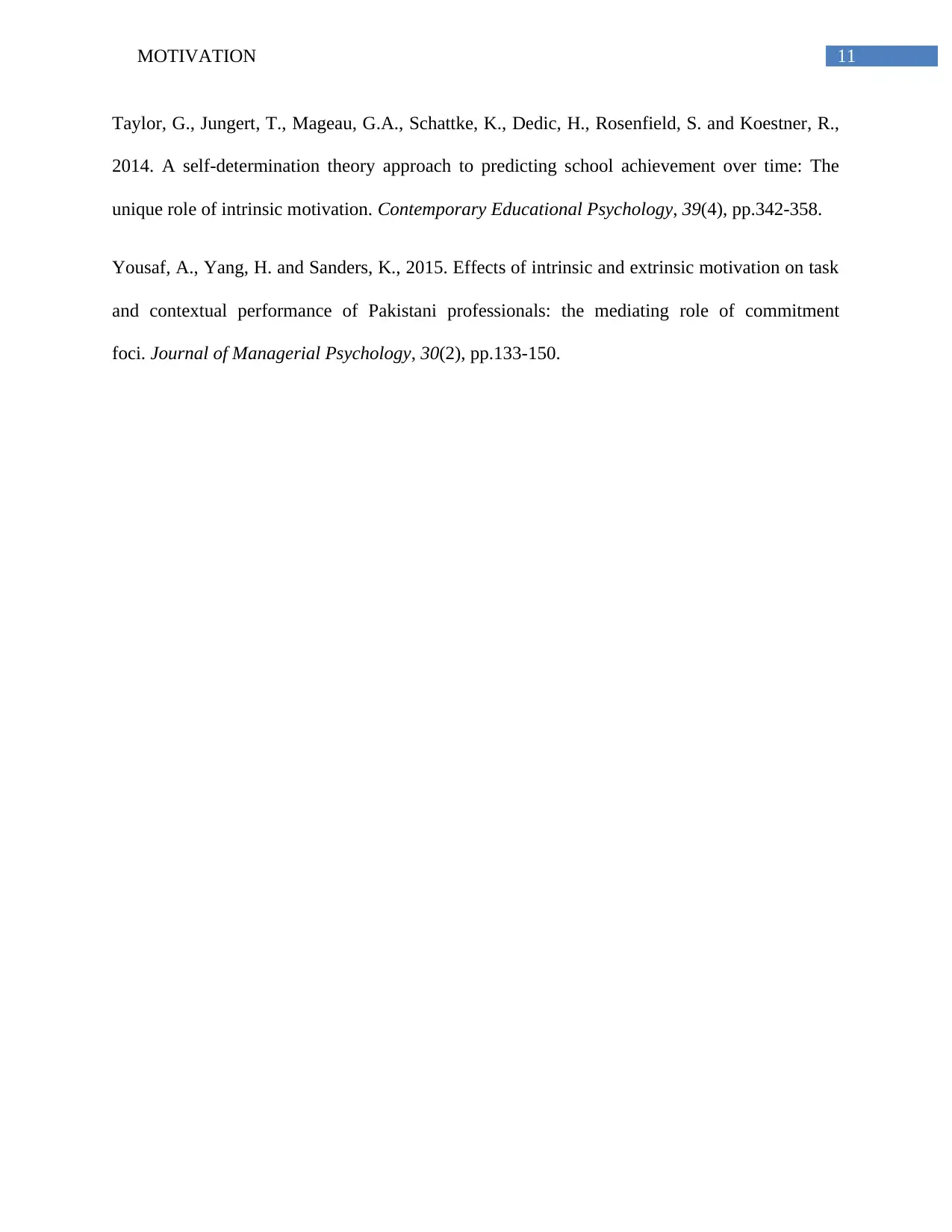
11MOTIVATION
Taylor, G., Jungert, T., Mageau, G.A., Schattke, K., Dedic, H., Rosenfield, S. and Koestner, R.,
2014. A self-determination theory approach to predicting school achievement over time: The
unique role of intrinsic motivation. Contemporary Educational Psychology, 39(4), pp.342-358.
Yousaf, A., Yang, H. and Sanders, K., 2015. Effects of intrinsic and extrinsic motivation on task
and contextual performance of Pakistani professionals: the mediating role of commitment
foci. Journal of Managerial Psychology, 30(2), pp.133-150.
Taylor, G., Jungert, T., Mageau, G.A., Schattke, K., Dedic, H., Rosenfield, S. and Koestner, R.,
2014. A self-determination theory approach to predicting school achievement over time: The
unique role of intrinsic motivation. Contemporary Educational Psychology, 39(4), pp.342-358.
Yousaf, A., Yang, H. and Sanders, K., 2015. Effects of intrinsic and extrinsic motivation on task
and contextual performance of Pakistani professionals: the mediating role of commitment
foci. Journal of Managerial Psychology, 30(2), pp.133-150.
⊘ This is a preview!⊘
Do you want full access?
Subscribe today to unlock all pages.

Trusted by 1+ million students worldwide
1 out of 12
Related Documents
Your All-in-One AI-Powered Toolkit for Academic Success.
+13062052269
info@desklib.com
Available 24*7 on WhatsApp / Email
![[object Object]](/_next/static/media/star-bottom.7253800d.svg)
Unlock your academic potential
Copyright © 2020–2025 A2Z Services. All Rights Reserved. Developed and managed by ZUCOL.



